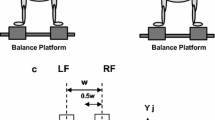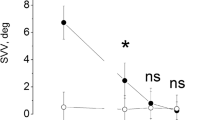Summary
Since during active eye-head turning the eyes move first and with higher velocity than the head, the lines of sight reach the target while the head is still moving. Then for the remaining duration of the head movement the eyes maintain their fixation by performing a movement which is counter to that of the head and perfectly compensates for it. It is agreed that this compensatory eye movement is critically influenced by visual, vestibular and neck afferents and that it is not initiated centrally. We have investigated a) the relative contribution of the vestibular and neck afferents to the compensatory eye movement made during active and passive head turning in monkeys and b) the mechanisms underlying the recovery of compensatory eye movements following either the removal of the vestibular or neck loop or both. Our results have shown that 1. normal monkeys display perfect ocular stability in darkness, 2. at least 95% of ocular stability is due to the vestibular loop, and 3. the contribution of the neck loop is negligible. Following bilateral vestibulectomy the recovery of compensatory eye movements occurs gradually and reaches 90% within seven weeks but only during active head movements. We have shown that there are at least three mechanisms underlying this recovery: 1. an increase in gain of the neck loop. 2. the occurrence of a centrally programmed compensatory eye movement, and 3. a recalibration of the saccadic and head motor system.
Similar content being viewed by others
References
Apter, J.T.: Bye movements following strychninization of the superior colliculus of cats. J. Neurophysiol. 9, 73–78 (1946)
Atkin, A., Bender, M.B.: Ocular stabilization during oscillatory head movements. Arch. Neurol. (Chic.) 19, 559–566 (1968)
Bárány, R.: Augenbewegungen durch Thoraxbewegungen ausgelöst. Zbl. Physiol. 20, 298–302 (1906)
Bender, M.B., Feldman, M.: Visual illusions during head movement in lesions of the brain stem. Arch. Neurol. (Chic.) 17, 354–364 (1967)
Bizzi, E., Kalil, R.E., Morasso, P., Tagliasco, V.: Central programming and peripheral feed-back during eye-head coordination in monkeys. In: Cerebral Control of Eye Movements and Motion Perception, pp. 220–232. Ed. by J. Dichgans and E. Bizzi. Basel: S. Karger 1972
—, Tagliasco, V.: Eye-head coordination in monkeys: evidence for centrally patterned organization. Science 173, 452–454 (1971)
Bond, H.W., Ho, P.: Solid miniature silver-silver chloride electrodes for chronic implantation. Electroenceph. din. Neurophysiol. 28, 206–208 (1970)
De Klein, A.: Actions réflexes du labyrinthe et du cou sur les muscles de l'oeil. Arch, néerl. Physiol. 2, 644–649 (1918)
Dichgans, J., Schmidt, C.L., Wist, E.R.: Frequency modulation of afferent and efferent unit activity in the vestibular nerve by oculomotor impulses. In: Progress in Brain Research, 37, 449–456. Ed. by A. Brodal and O. Pompeiano. Amsterdam: Elsevier 1972
Engström, H.: On the double innervation of the sensory epithelia of the inner ear. Acta oto-laryng. (Stockh.) 49, 109–118 (1958)
Evarts, E.V.: A technique for recording activity of subcortical neurons in moving animals. Electroenceph. clin. Neurophysiol. 24, 83–86 (1968)
Ewald, J.R.: Physiologische Untersuchungen über das Endorgan des Nervus octavus. Wiesbaden: Bergmann 1892
Fernandez, C., Goldberg, J.M.: Physiology of peripheral neurons innervating semicircular canals of the squirrel monkey. II. Response to sinusoidal stimulation and dynamics of peripheral vestibular system. J. Neurophysiol. 34, 661–675 (1971)
Ford, F.R., Walsh, F.B.: Clinical observations upon the importance of vestibular reflexes on ocular movements: effects of section of one or both vestibular nerves. Bull. Hopkins Hosp. 58, 80–88 (1936)
Fuchs, A.F.: Saccadic and smooth pursuit eye movements in the monkey. J. Physiol. (Lond.) 191, 609–631 (1967)
Gacek, R.R.: The course and central termination of first-order neurons supplying vestibular end-organs in the cat. Acta otolaryng. (Stockh.) Suppl. 254, 1–66 (1969)
Hillmann, D.E.: Light and electron microscopical study of the relationships. between the cerebellum and the vestibular organ of the frog. Exp. Brain Res. 9, 1–15 (1966)
Lundberg, A.: Supraspinal control of transmission in reflex paths to motoneurons and primary afferents. In: Physiology of Spinal Neurons. Progress in Brain Research 12, edited by J.C. Eccles and J.P. Schade. Amsterdam: Elsevier 1964
Meiry, J.L.: Vestibular and proprioceptive stabilization of eye movement. In: The Control of Eye Movements, pp. 483–496. Ed. by P. Bach-y-Rita, C. Collins and J.E. Hyde. New York-London: Academic Press 1971
Melvill-Jones, G., Milsum, J.H.: Frequency response analysis of central vestibular unit activity resulting from rotational stimulation of the semicircular canals. J. Physiol. (Lond.) 219, 191–215 (1971)
Morasso, P., Bizzi, E., Dichgans, J.: Adjustment of saccade characteristics during head movements. Exp. Brain Res. 16, 492–500 (1973)
- Graham, J.: Problems of data collection, reduction, and analysis in a neurophysiological laboratory. Proceedings of the First Bioengineering Meeting, June, 1972, Milano, Italy (in press)
Precht, W.: Vestibular and cerebellar control of oculomotor functions: In: Cerebral Control of Eye Movements and Motion Perception, pp. 71–88. Ed. by J. Dichgans and E. Bizzi. Basel: S. Karger 1972
Robinson, A.: On the nature of visual-oculomotor connections. Invest. Ophthal. 11, 497–503 (1972)
Robinson, D.A.: Eye movements evoked by superior colliculus stimulation in the alert monkey. Assoc. Res. Vision Ophthalmol. Sarasota, Florida, 1971
Rossi, G., Cortesina, G.: The afferent cochlear and vestibular system in lepus cuniculus. Acta anat. (Basel) 60, 362–381 (1965)
Schiller, P.H., Körner, F.: Discharge characteristics of single units in the superior colliculus of the alert rhesus monkey. J. Neurophysiol. 24, 920–936 (1972)
Steinhausen, W.: Über die Beobachtung der Cupula in den Bogengangsampullen des Labyrinths des lebenden Hechtes. Pflügers Arch. ges. Physiol. 232, 500–512 (1933)
Suzuki, J.-I.: Vestibular and spinal control of eye movements. In: Cerebral Control of Eye Movements and Motion Perception, pp. 109–115. Ed. by J. Dichgans and E. Bizzi. Basel: S. Karger 1972
Szentágothai, J.: The elementary vestibulo-ocular reflex arc. J. Neurophysiol. 13, 395–407 (1950)
Wall, P.D.: The laminar organization of dorsal horn and effects of descending impulses. J. Physiol. (Lond.) 188, 403–423 (1967)
Wersäll, J.: Studies on the structure and innervation of the sensory epithelijum of the cristae ampullares in the guinea pig. Acta otolaryng. (Stockh.) Suppl. 126 (1956)
Young, L.R.: The current status of vestibular system models. Automatica 5, 369–383 (1969)
Author information
Authors and Affiliations
Additional information
Research supported by NIH grant NS09343; NASA grant NGR-22-009-308. J. Dichgans was supported by the Sloan Foundation and Deutsehe Forschungsgemeinschaft (Sonderforschungsbereich 70). P. Morasso was supported by the Sloan Foundation and C.N.R. Programma Speciale Tecnologie Biomediche. We thank J. Graham for technical assistance.
Rights and permissions
About this article
Cite this article
Dichgans, J., Bizzi, E., Morasso, P. et al. Mechanisms underlying recovery of eye-head coordination following bilateral labyrinthectomy in monkeys. Exp Brain Res 18, 548–562 (1973). https://doi.org/10.1007/BF00234137
Received:
Issue Date:
DOI: https://doi.org/10.1007/BF00234137




